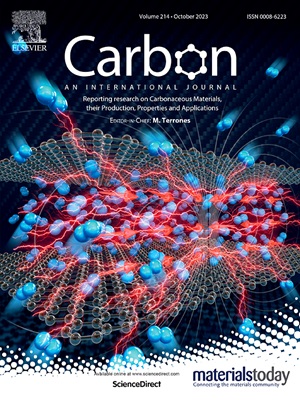Construction of 1D porous MOF-derived ZnO/C fibers anchored by 0D cobalt nanoparticles for enhanced microwave absorption and thermal conductivity
IF 10.5
2区 材料科学
Q1 CHEMISTRY, PHYSICAL
引用次数: 0
Abstract
As to most traditional microwave-absorbing materials, weak thermal conductivity and narrow absorption bandwidth have greatly limited their practical applications. In this work, a novel synthesis strategy was put forward to construct the porous one-dimensional (1D) ZnO/C fibers anchored by zero-dimensional (0D) cobalt nanoparticles (Co–ZnO/C) via a synergistic approach combining electrospinning, seed-assisted growth of ZnCo bimetal-organic frameworks (MOFs), and carbonization processes. Changing metal cobalt ion ratios in the fibers can effectively adjust the graphitization degree and electromagnetic parameters, and then correspondingly enhance the microwave absorption performance. Further, reduced cobalt nanoparticles significantly amplify interfacial polarization and magnetic loss, while the hierarchical porous structure optimizes impedance matching. Consequently, increasing the cobalt contents leads to an improvement in RLmin from −50.83 dB to −63.42 dB, albeit with a slight decrease in the EABmax from 7.28 GHz (10.72–18.00 GHz) at 2.50 mm to 7.04 GHz (9.12–16.16 GHz) at 2.90 mm. Excessive addition of cobalt ion can also result in a decrease in microwave absorption performance. Specific porous 1D structure extends the electron transport path and enhances thermal conductivity of the Co–ZnO/C composites. The corresponding thermal conductivity reaches 0.318 W m−1 K−1, which is 40 % higher than that of pure epoxy resin. The superior electromagnetic wave absorption performance, coupled with the elevated thermal conductivity, renders the as-synthesized Co–ZnO/C composites highly promising for application in the design and manufacture of next-generation wireless communication equipment and high power devices.
0D钴纳米颗粒锚定一维多孔mof衍生ZnO/C纤维增强微波吸收和导热性的构建
传统吸波材料导热性弱、吸收带宽窄,极大地限制了其实际应用。本文提出了一种新的合成策略,通过静电纺丝、种子辅助生长ZnCo双金属有机框架(mof)和碳化工艺相结合的协同方法,构建由零维(0D)钴纳米颗粒(Co-ZnO /C)锚定的多孔一维(1D) ZnO/C纤维。改变光纤中金属钴离子的比例,可以有效调节石墨化程度和电磁参数,从而相应地提高光纤的微波吸收性能。此外,还原钴纳米颗粒显著增强了界面极化和磁损耗,而分层多孔结构优化了阻抗匹配。因此,增加钴含量导致RLmin从−50.83 dB提高到−63.42 dB,尽管EABmax从2.50 mm处的7.28 GHz (10.72 ~ 18.00 GHz)略微降低到2.90 mm处的7.04 GHz (9.12 ~ 16.16 GHz)。过量加入钴离子也会导致微波吸收性能下降。特定的一维多孔结构扩展了Co-ZnO /C复合材料的电子传递路径,提高了其导热性。热导率达到0.318 W m−1 K−1,比纯环氧树脂高40%。优异的电磁波吸收性能,加上更高的导热性,使得合成的Co-ZnO /C复合材料在下一代无线通信设备和大功率器件的设计和制造中具有很大的应用前景。
本文章由计算机程序翻译,如有差异,请以英文原文为准。
求助全文
约1分钟内获得全文
求助全文
来源期刊

Carbon
工程技术-材料科学:综合
CiteScore
20.80
自引率
7.30%
发文量
0
审稿时长
23 days
期刊介绍:
The journal Carbon is an international multidisciplinary forum for communicating scientific advances in the field of carbon materials. It reports new findings related to the formation, structure, properties, behaviors, and technological applications of carbons. Carbons are a broad class of ordered or disordered solid phases composed primarily of elemental carbon, including but not limited to carbon black, carbon fibers and filaments, carbon nanotubes, diamond and diamond-like carbon, fullerenes, glassy carbon, graphite, graphene, graphene-oxide, porous carbons, pyrolytic carbon, and other sp2 and non-sp2 hybridized carbon systems. Carbon is the companion title to the open access journal Carbon Trends. Relevant application areas for carbon materials include biology and medicine, catalysis, electronic, optoelectronic, spintronic, high-frequency, and photonic devices, energy storage and conversion systems, environmental applications and water treatment, smart materials and systems, and structural and thermal applications.
 求助内容:
求助内容: 应助结果提醒方式:
应助结果提醒方式:


